3. Workspaces and Role-based Access Control¶
The SystemLink role-based access control (RBAC) system provides strong isolation between different workspaces as well as fine grain privileges for systems, data, and analysis routines in SystemLink. Collectively this capability allows access to SystemLink to scale user and data access beyond a single team to an entire organization.
3.1 Concepts¶
SystemLink RBAC leverages common concepts such as roles and users. It also introduces concepts such as workspaces and automatic data encapsulation to ensure strict access control of data produced by test systems.
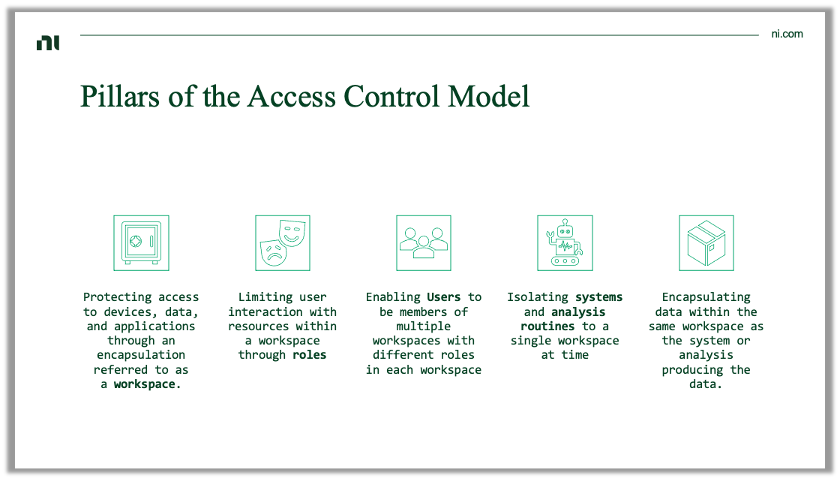
3.1.1 Workspace¶
A workspace is a complete encapsulation of all systems, data, and other resources within SystemLink. A user must be a member of a workspace to access the systems and data within the workspace. This is true for access via the SystemLink web application and the SystemLink REST API.
SystemLink always has at least one workspace, Default, created at install time. Like all workspaces,the default workspace may be renamed or 3.1.1.2 archived, but it has a additional properties to support backwards compatibility with pre-2020R1 SystemLink clients.
Properties of the Default workspace
-
All clients using AMQP for network communication exclusively publish data to the default workspace.
-
All pre-2020R1 clients using HTTP for network communication exclusively publish data to the default workspace.
-
OPC UA and Cloud Connector sessions always exist in the default workspace and may only access tags in the default workspace.
-
File moving rules always exist in the default workspace and may only access files in the default workspace.
-
Health tags for the SystemLink server are always published to the default workspace.
The SystemLink Advanced Server license is required to create multiple workspaces, but there is no limit on the number of workspaces that can be created. Refer to the SystemLink Manual for steps to create a workspace.
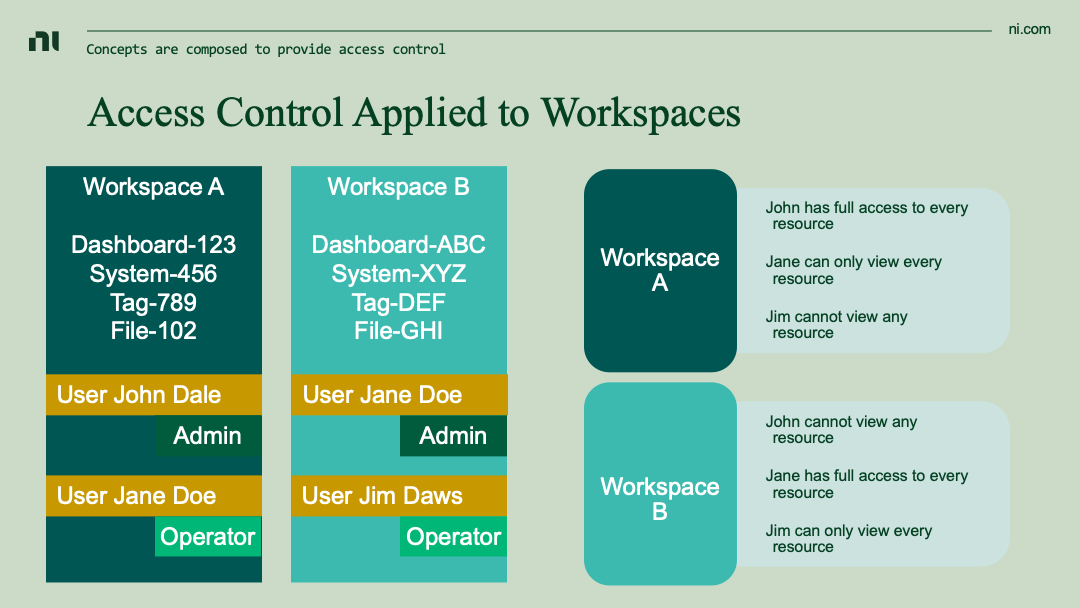
Systems, data, and analysis routines (collectively referred to as resources) are unique to individual workspaces. No resource occupies multiple workspaces. Some resources may be moved between workspaces. If a resource is duplicated the user is prompted to choose a workspace for the new resource.
3.1.1.1 Exceptions for Workspaces¶
The following resources in SystemLink have limitations or exceptions from the broader rules described above.
-
DataFinder: DataFinder instances are global (meaning any user can view the DataFinder instance), but DataFinder Search Areas defined within a DataFinder instance are scoped to a single workspace. Search areas can only index File Ingestion Service data for the DataFinder Search Area's corresponding workspace. All indexed files of a search area are available only to members of the corresponding workspace.
-
Notifications: Notification strategies, groups, and email templates are not scoped to a single workspace. These may be used with any alarm rule regardless of the workspace of the alarm rule. Roles may still restrict access to notification configuration.
-
Jupyter Notebook: Jupyter Notebooks are not managed by SystemLink's RBAC. Refer to Sharing a Jupyter Notebook for details on how to allow multiple users collaborate with Notebooks.
3.1.1.2 Archived Workspaces¶
Workspaces may be archived if they are no longer in use. Archiving does not delete resources or move resources to a new database or file storage location. Archived workspaces are only accessible to users with the 3.1.2.2 Server Administrator role. Resources in archived workspaces cannot be created, updated, or deleted. Resources may be duplicated or moved into a non-archived workspace. All active alarms are automatically cleared when a workspace is archived.
Refer to the SystemLink manual for steps to manage archived workspaces.
3.1.2 Users and Roles¶
Roles define the privileges a user, system, or analysis procedure may take against resources within SystemLink. While roles are applied within the context of a workspace, roles are defined globally. This enables the same role to be used across multiple workspaces. Refer to the SystemLink manual for steps to manage roles.
Role privileges explicitly grant what you can do - there are no deny privileges. Due to this a user may be assigned multiple roles within a single workspace that collectively describe what the user has access to. This is useful to prevent the proliferation of multiple different roles that have similar privileges. Instead, simple roles may be defined and composed together by assigning a user each role.
Allow all privileges
In each area of available privileges there is an Allow all privileges option. This privilege automatically grants all privileges for that area. If a new privilege is in a future version of SystemLink, users with Allow all privileges will automatically be granted the new privilege upon upgrade. If this behavior is undesirable, refrain from using Allow all privileges.
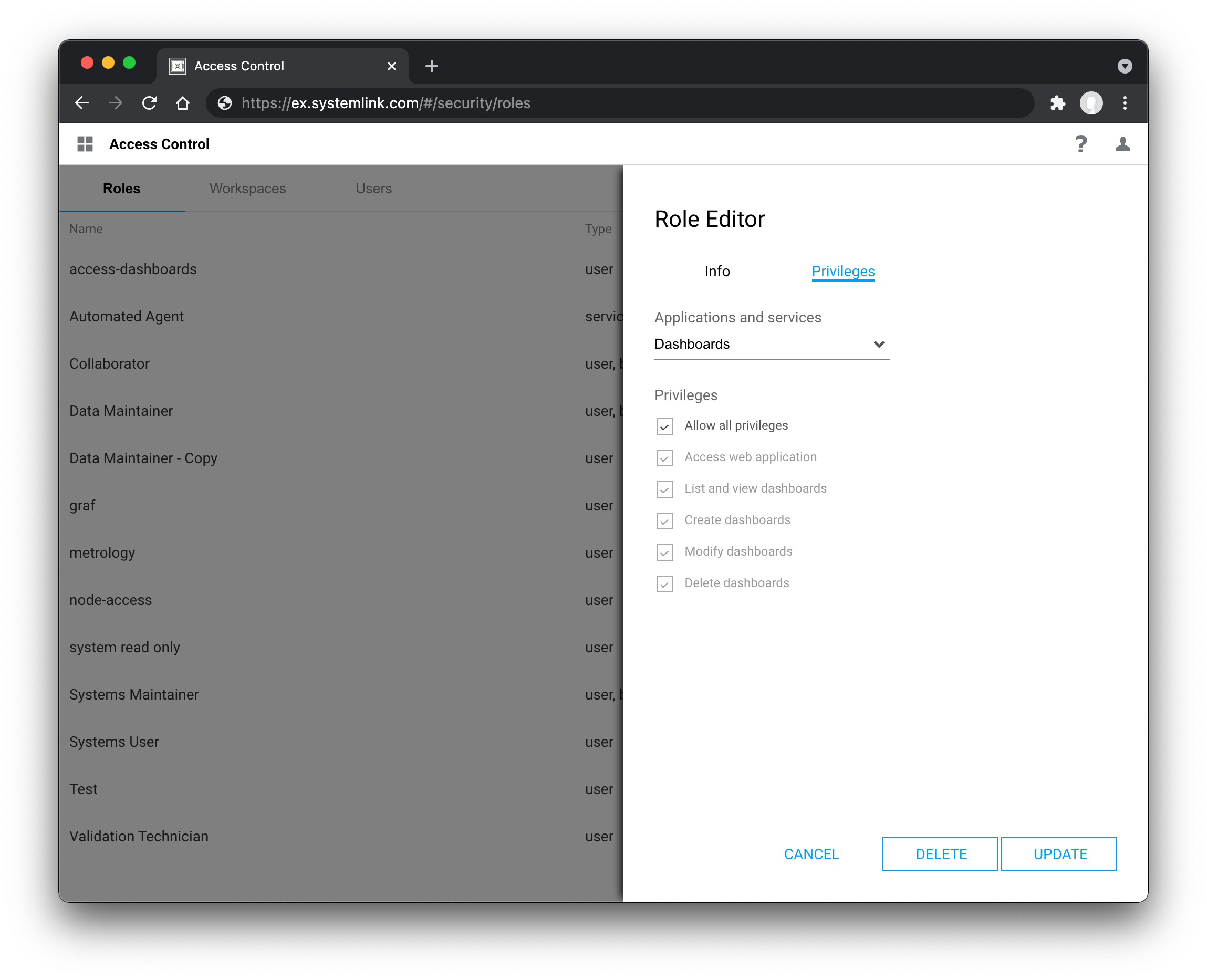
3.1.2.1 Built-in and Custom Roles¶
When creating and assigning roles, it is best practice to provide users with the minimum number of privileges to perform their work. SystemLink has granular privileges for services and applications in the product. These privileges also include access to individual SystemLink applications such as Systems Management and Test Insights.
Note
If a user has a role that grants access to an application in any workspace that application will be available to the user at all times. If a user has not been granted access to an application in any workspace that application will be hidden from the navigation menu.
The privilege to access a web application is not sufficient for to view, list, create, modify, or delete resource exposed by the web application. Additional privileges for those resources must be granted.
Custom roles may be created, duplicated, modified, and deleted as needed. If a role is updated all users mapped to that role are affected.
Due to the large number of privileges available SystemLink includes several built-in roles to facilitate getting started. Refer to the SystemLink manual for a summary of these roles. Go to the SystemLink Access Control application to review the details on privileges granted for each role.
Note
Built-in roles cannot be modified. They can be duplicated and the duplicated roles may be renamed and the privileges modified. This constraint exists because NI may add or change privileges for built-in roles between releases. Users assigned these built-in roles will have their privileges automatically change upon upgrade. To opt out of this behavior assign your users custom roles.
3.1.2.2 Server Administrator Role¶
SystemLink includes a special Server Administrator Role. This role has exclusive access to the Access Control application and can modify workspaces and roles. This role has full access to all of SystemLink, its applications, data, systems, etc. for every workspace. This is the most permissive role in SystemLink and should be used by users who administer access control for SystemLink exclusively.
The user admin created during the guided setup of NI Web Server Configuration is automatically assigned the Server Administrator role. This is done such that administrators can access the Access Control application during initial setup and configure access control via an identity provider. NI encourages disabling the admin user in the NI Web Server Configuration after you have assigned the Server Administrator role to users backed by your identity provider.
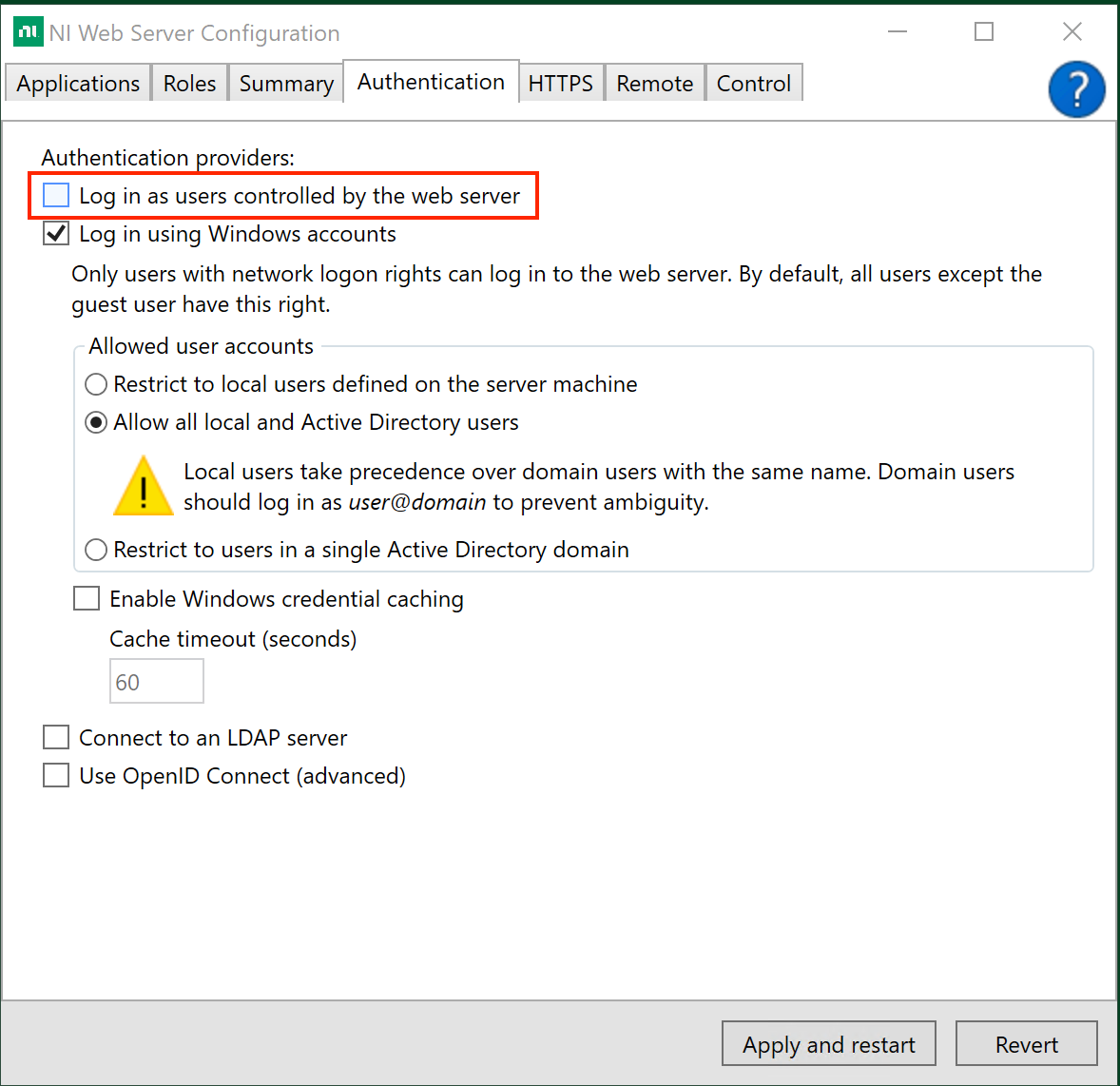
Users are mapped to the Server Administrator role by clicking the gear icon in the top right of the Roles tab in the Access Control application.
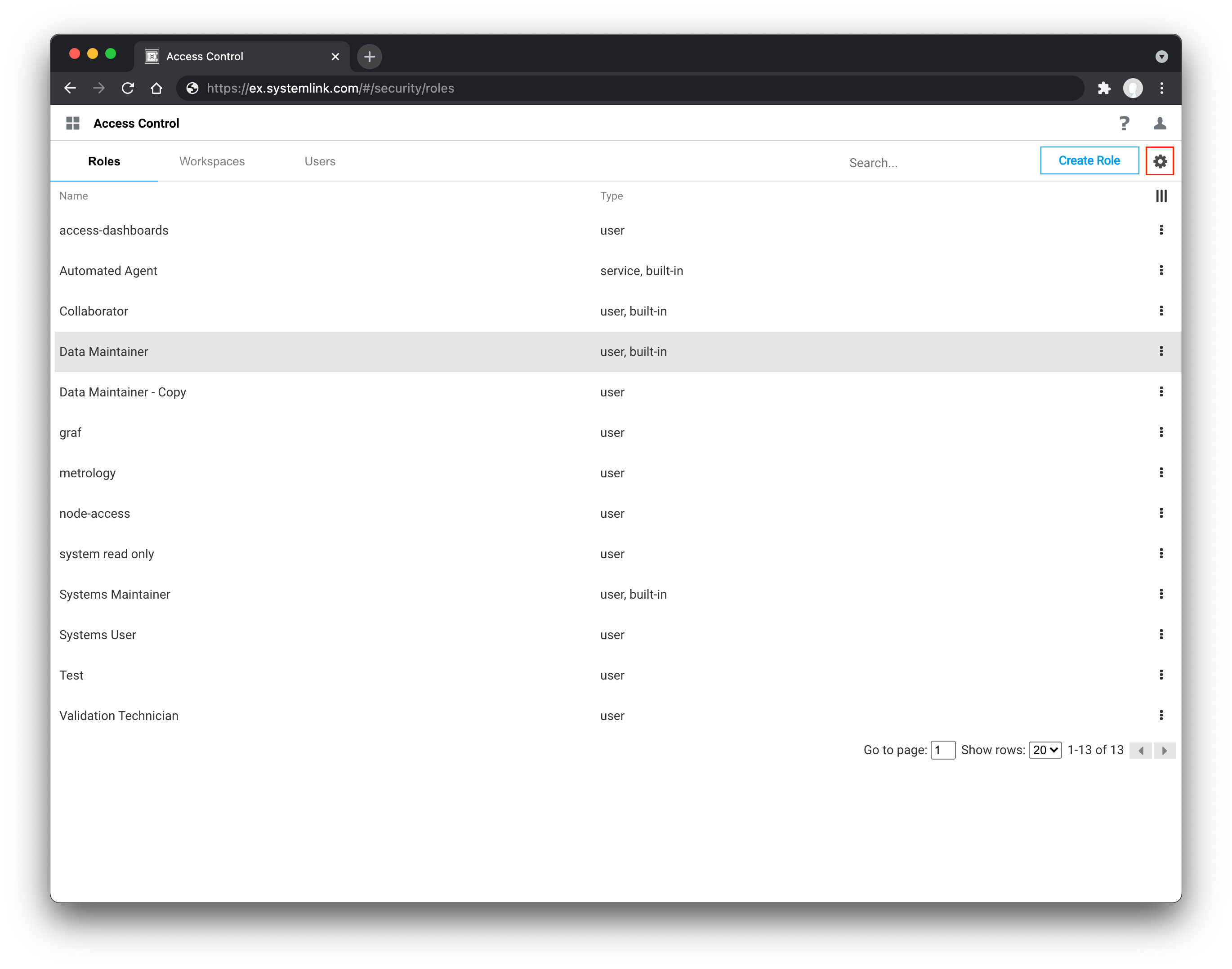

3.1.2.3 Users¶
Users are backed by an identity provider (IdP) such as LDAP, Active Directory, or OpenID Connect that provides authenticated access to SystemLink. This is in contrast to systems and analysis routines that are managed within SystemLink and are not backed by an identity provider.
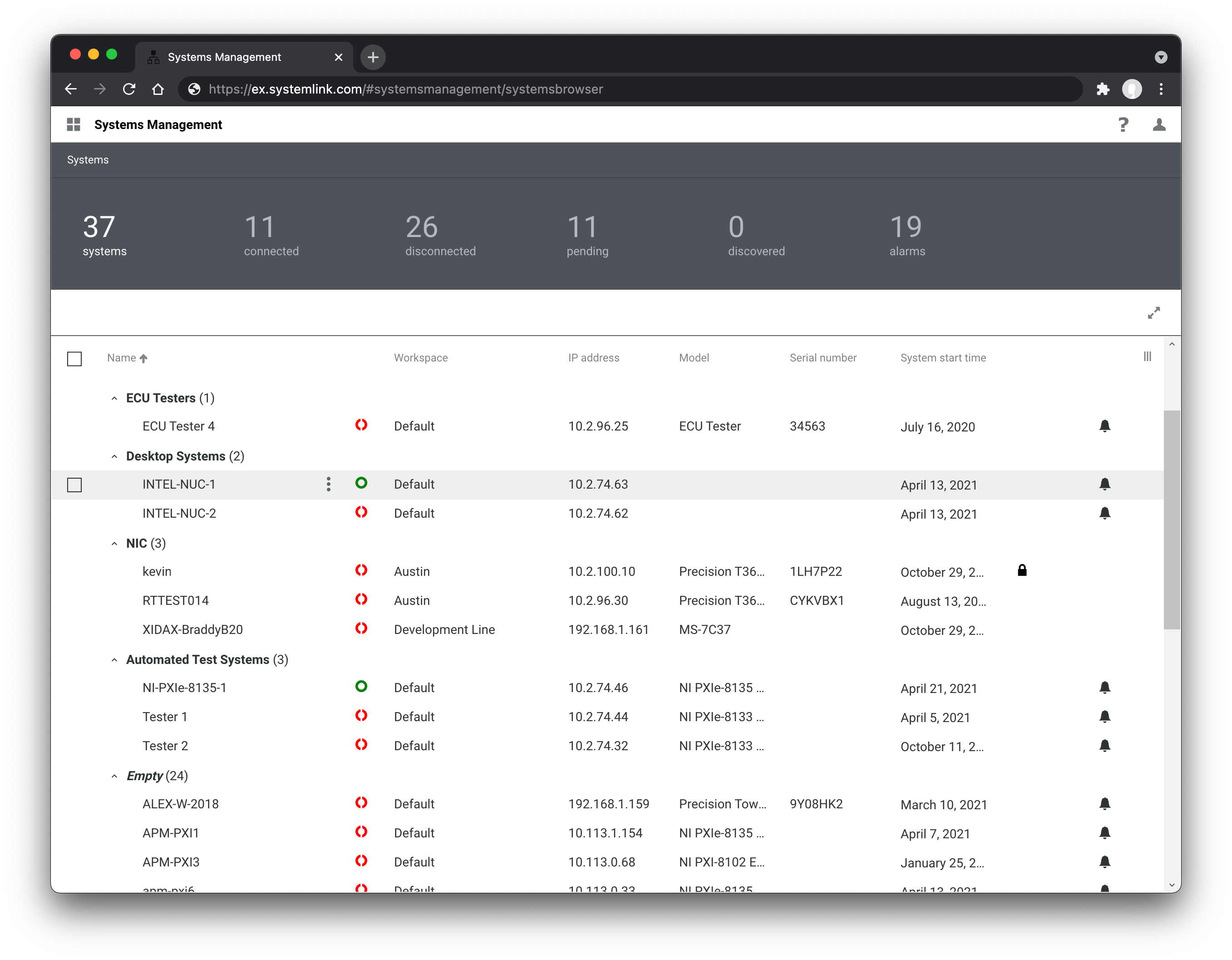
If a user is a member of multiple workspaces, the resources in those workspaces will be shown simultaneously within the grids and other views within SystemLink. This is useful when users need to view a rollup of resources across multiple workspaces. While resources in multiple workspaces may be viewed in a single grid, the actions a user can take against those resources may be different depending on their role in each workspace.
Considerations for WebVIs, dashboards, and Jupyter Notebooks
The privileges for WebVIs and dashboards control the create, view, update, and delete privileges for the WebVI and dashboard documents themselves. When a user opens and views a dashboard or WebVI the data they can access is determined by the privileges on the resources exposed by the WebVI or dashboard such as tags, queries, and notebooks. If a user does not have privileges to access the resources exposed by the WebVI or dashboard they will view no data.
When a user runs a Jupyter Notebook from a Report or dashboard, the Notebook executes with the same privileges as the user. This allows the creation of Notebooks without workspace logic. For example, the Test Insights dashboard includes a tile displaying system utilization over time. This tile will only show utilization for systems within the logged in user's workspaces. If the user does not have privileges to view systems, the tile returns no data.
3.1.2.4 Service roles¶
Service roles apply to SystemLink managed systems and analysis routines executed by Analysis Automation. Systems are always automatically assigned the built-in Automated Agent role. Analysis Automation routines can be configured to run with the built-in Automated Agent role, a user defined service role, with the privileges of the user initiating the analysis task, or with the TDM user (a Windows user on the SystemLink app server defined in NI SystemLink TDM Configuration).
Any custom role may be configured to be a service role at creation by toggling the Service role toggle button in the role configuration slide out. This cannot be changed after role creation. There are no restrictions on the privileges that may be applied to the role. It exists to signal to various SystemLink UIs what roles can be assigned to users and what roles can be assigned to systems and analysis routines. This forces the user to curtail roles appropriately to each scenario and avoid the proliferation of roles that grant greater access than is necessary to a user, system, or analysis routine.
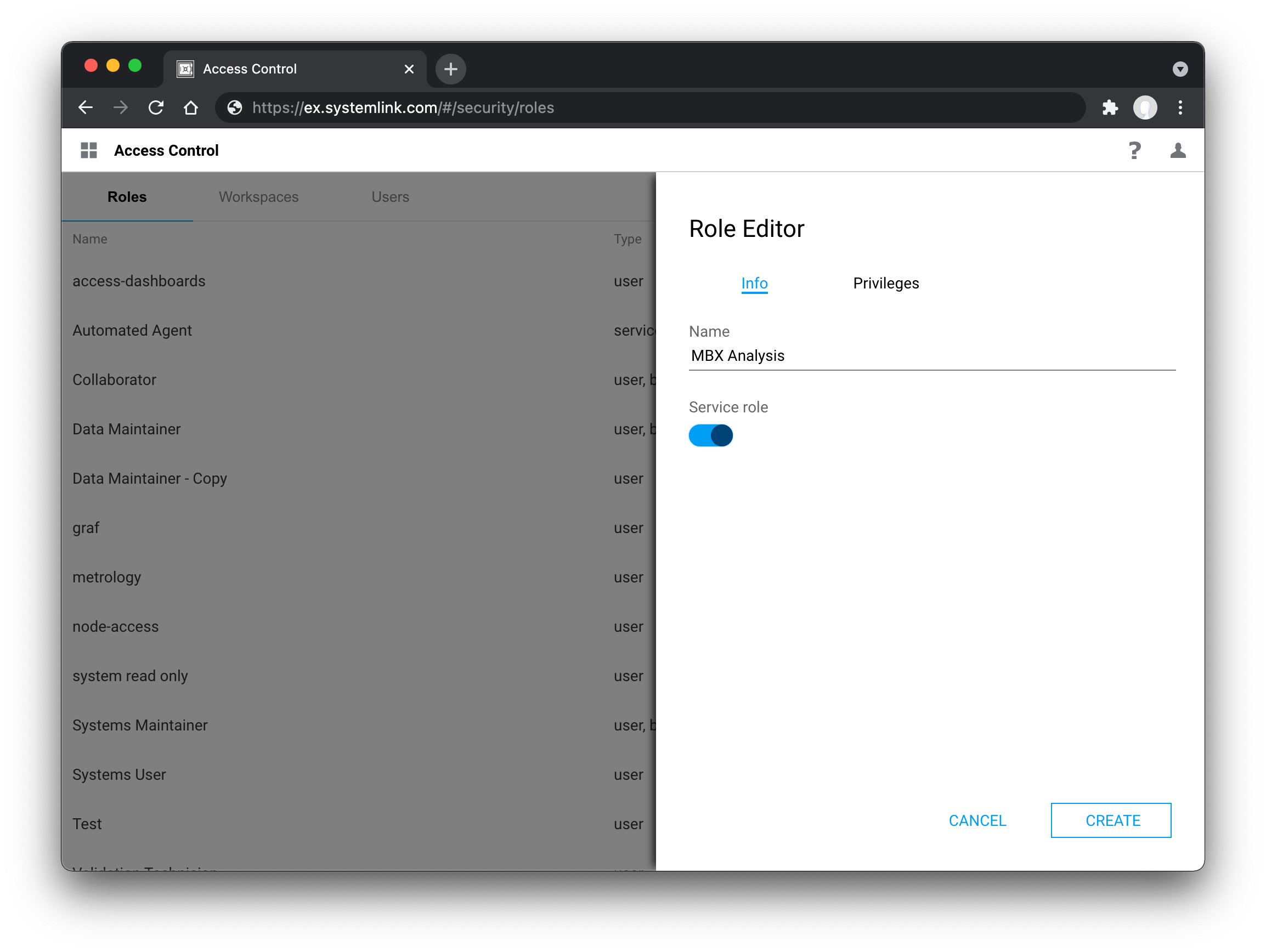
3.1.3 Automatic Data Encapsulation¶
When a system is added to SystemLink the user must choose in which workspace the system will reside. The workspaces available to the user are determined by both their workspace membership and Add systems privilege. Once added to a workspace, data produced by the system will automatically be stored in the same workspace as the system. This capability allows users to develop workspace agnostic test applications. Changing workspaces does not require changes or redeployment of test application. This is especially helpful when in scenarios such as production verification where the test application cannot change between validation and production but the validation data produced must be kept separate from production data.
Systems job history, asset and tag data
When a system is added to a workspace all its connected assets are also added to the same workspace. When a system is moved to another workspace its assets and job history are also moved. This is not the case with tags and tag history published by the system. These will be left in the original workspace and new tags are created in the new workspace.
3.2 Mapping users to roles in workspaces¶
Users are added to a workspace and assigned a role through a process called workspace and role mapping. The process is driven by metadata provided by the identity provider (IdP) user to authenticate users for SystemLink: OpenID Connect, LDAP, Active Directory, or local Windows accounts. Refer to the documentation for each of the IdP types for details on how to configure workspace and role mapping. By using metadata from an IdP you can create mappings that on-board large numbers of users into SystemLink using existing Active Directory and LDAP groups and OpenID Connect claims.